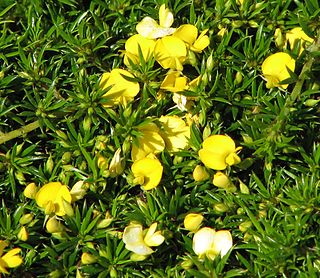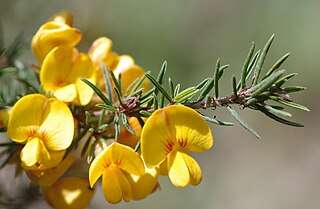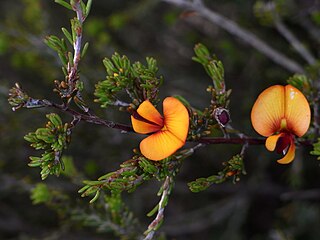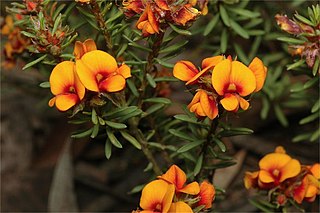
Pultenaea scabra, commonly known as rough bush-pea, is a species of flowering plant in the family Fabaceae and is endemic to south-eastern continental Australia. It is an erect or spreading shrub with hairy stems, heart-shaped leaves with the narrower end towards the base, and yellow and red, pea-like flowers.

Pultenaea gunnii, commonly known as golden bush-pea, is a species of flowering plant in the family Fabaceae and is endemic to south-eastern Australia. It is a slender, erect to spreading shrub with hairy young stems, egg-shaped to lance-shaped leaves with lance-shaped stipules at the base, and bright yellow and dark red flowers.

Pultenaea juniperina, commonly known as prickly bush-pea or prickly beauty is a species of flowering plant in the family Fabaceae and is endemic to south-eastern Australia. It is an erect, spiky shrub with hairy stems, linear to narrow elliptic leaves with stipules at the base, and yellow-orange and red flowers.

Pultenaea pedunculata, commonly known as matted bush-pea, is a species of flowering plant in the family Fabaceae and is endemic to south-eastern Australia. It is a prostrate, densely matted shrub with softly-hairy branches that often form roots, narrow elliptic leaves, and bright yellow and brick-red flowers.

Pultenaea blakelyi, commonly known as Blakely's bush-pea, is a species of flowering plant in the family Fabaceae and is endemic to south-eastern continental Australia. It is an erect shrub with sharply-pointed, narrow elliptic to egg-shaped leaves and yellow to orange flowers in open clusters in leaf axils or at the ends of branches.

Pultenaea villosa, commonly known as hairy bush-pea, is a species of flowering plant in the family Fabaceae and is endemic to eastern Australia. It is a shrub with softly-hairy foliage, narrow elliptic to linear, oblong to club-shaped leaves, and yellow-orange and reddish-brown, pea-like flowers.

Pultenaea mollis, commonly known as soft bush-pea or guinea flower bush pea, is a species of flowering plant in the family Fabaceae and is endemic to south-eastern Australia. It is an erect or spreading shrub with narrow linear to elliptic or needle-shaped leaves and clusters of up to ten yellow to orange flowers with red markings.

Pultenaea aristata, commonly known as bearded bush-pea or prickly bush-pea, is a species of flowering plant in the family Fabaceae and is endemic to New South Wales. It is a small, erect shrub with linear to narrow elliptic, sharp-tipped leaves, and yellow and red flowers.
Pultenaea canescens, commonly known as plumed bush-pea, is a species of flowering plant in the family Fabaceae and is endemic to a small area in eastern New South Wales. It is an erect shrub with narrow elliptic to narrow egg-shaped leaves, and yellow to orange flowers with reddish-brown markings.

Pultenaea capitellata, commonly known as hard-head bush-pea, is a species of flowering plant in the family Fabaceae and is endemic to south-eastern continental Australia. It is a sprawling to prostrate shrub with elliptic to broadly egg-shaped leaves, and yellow to orange flowers with a red to purple keel.

Pultenaea foliolosa, commonly known as the small-leaf bush-pea, is a species of flowering plant in the family Fabaceae and is endemic to eastern Australia. It is an erect to low-lying shrub with elliptic to oblong leaves that are concave on the upper surface, and yellow to orange and reddish-brown flowers.

Pultenaea hispidula, commonly known as rusty bush-pea, is a species of flowering plant in the family Fabaceae and is endemic to south-eastern continental Australia. It is an erect, spreading shrub with many drooping branches, oblong to egg-shaped leaves with the narrower end towards the base, and yellow to pale orange and red flowers.

Pultenaea linophylla, commonly known as halo bush-pea, is a species of flowering plant in the family Fabaceae and is endemic to south-eastern continental Australia. It is an erect or prostrate shrub with spreading branches, linear to elliptic or wedge-shaped leaves, and yellow to orange and red to purple flowers.

Pultenaea polifolia, commonly known as dusky bush-pea, is a species of flowering plant in the family Fabaceae and is endemic to south-eastern continental Australia. It is an erect to prostrate shrub with linear or elliptic to egg-shaped leaves with the narrower end towards the base, and yellow to orange and red to purple flowers.

Pultenaea procumbens, commonly known as heathy bush-pea, is a species of flowering plant in the family Fabaceae and is endemic to south-eastern continental Australia. It is a low-lying or spreading shrub with lance-shaped or rhombic leaves and yellow, orange and red flowers.

Pultenaea prostrata, commonly known as silky bush-pea, is a species of flowering plant in the family Fabaceae and is endemic to south-eastern Australia. It is a small, rigid, wiry, low-lying or prostrate shrub with cylindrical leaves, and yellow, red and purple-brown flowers.
Pultenaea sericea, commonly known as chaffy bush-pea, is a species of flowering plant in the family Fabaceae and is endemic to south-eastern Australia. It is a small, straggling shrub with hairy branches, elliptic to linear leaves, and yellow and red to purple, pea-like flowers.

Pultenaea subspicata, commonly known as low bush-pea, is a species of flowering plant in the family Fabaceae and is endemic to south-eastern continental Australia. It is a low-lying, prostrate or mat-forming shrub with elliptic leaves and yellow to pink and orange-red, pea-like flowers.
Pultenaea villifera is a species of flowering plant in the family Fabaceae and is endemic to two disjunct areas of Australia. It is an erect to prostrate shrub with triangular to linear, egg-shaped to elliptic leaves and yellow and red, pea-like flowers.

Pultenaea vrolandii, commonly known as cupped bush-pea, is a species of flowering plant in the family Fabaceae and is endemic to south-eastern continental Australia. It is an erect shrub with hairy, arching branchlets, elliptic to egg-shaped leaves, and yellow to orange and red to brown flowers.

















